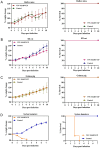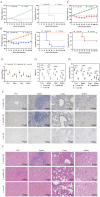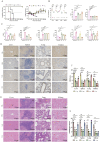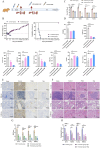A surrogate BSL2-compliant infection model recapitulating key aspects of human Marburg virus disease
- PMID: 39745141
- PMCID: PMC11727069
- DOI: 10.1080/22221751.2024.2449083
A surrogate BSL2-compliant infection model recapitulating key aspects of human Marburg virus disease
Abstract
Marburg virus disease (MVD) is a severe infectious disease caused by the Marburg virus (MARV), posing a significant threat to humans. MARV needs to be operated under strict biosafety Level 4 (BSL-4) laboratory conditions. Therefore, accessible and practical animal models are urgently needed to advance prophylactic and therapeutic strategies for MARV. In this study, we constructed a recombinant vesicular stomatitis virus (VSV) expressing the Marburg virus glycoprotein (VSV-MARV/GP). Syrian hamsters infected with VSV-MARV/GP presented symptoms such as thrombocytopenia, lymphopenia, haemophilia, and multiorgan failure, developing a severe systemic disease akin to that observed in human MARV patients. Notably, the pathogenicity was found to be species-specific, age-related, sex-associated, and challenge route-dependent. Subsequently, the therapeutic efficacy of the MR191 monoclonal antibody was validated in this model. In summary, this alternative model is an effective tool for rapidly screening medical countermeasures against MARV GP in vivo under BSL-2 conditions.
Keywords: Marburg virus; Syrian hamster; recombinant vesicular stomatitis virus; recurrence of classic symptoms; surrogate model; vaccine evaluation and drug screening.
Conflict of interest statement
No potential conflict of interest was reported by the author(s).
Figures







Similar articles
-
A Surrogate Animal Model for Screening of Ebola and Marburg Glycoprotein-Targeting Drugs Using Pseudotyped Vesicular Stomatitis Viruses.Viruses. 2020 Aug 22;12(9):923. doi: 10.3390/v12090923. Viruses. 2020. PMID: 32842671 Free PMC article.
-
Establishment and application of a surrogate model for human Ebola virus disease in BSL-2 laboratory.Virol Sin. 2024 Jun;39(3):434-446. doi: 10.1016/j.virs.2024.03.010. Epub 2024 Mar 29. Virol Sin. 2024. PMID: 38556051 Free PMC article.
-
A Hamster Model for the Evaluation of Marburg Virus Countermeasures.Methods Mol Biol. 2025;2877:227-238. doi: 10.1007/978-1-0716-4256-6_16. Methods Mol Biol. 2025. PMID: 39585625
-
Marburg virus pathogenesis - differences and similarities in humans and animal models.Virol J. 2019 Dec 30;16(1):165. doi: 10.1186/s12985-019-1272-z. Virol J. 2019. PMID: 31888676 Free PMC article. Review.
-
Marburg Virus Medical Countermeasures.Methods Mol Biol. 2025;2877:25-43. doi: 10.1007/978-1-0716-4256-6_2. Methods Mol Biol. 2025. PMID: 39585611 Review.
References
MeSH terms
Substances
LinkOut - more resources
Full Text Sources
